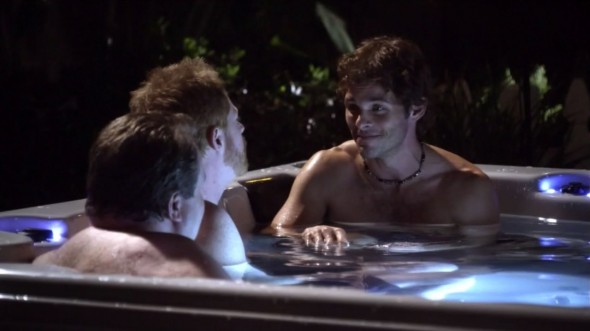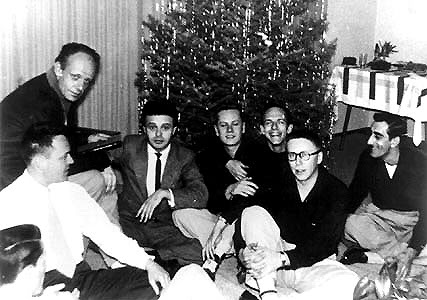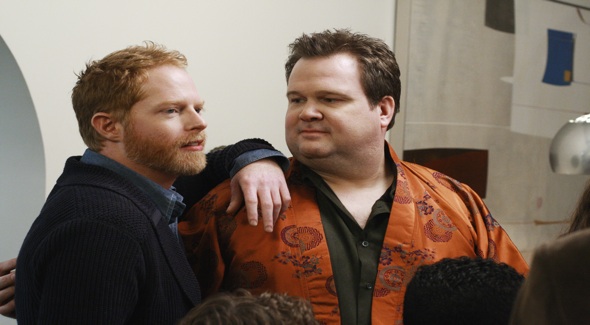As of this writing, in the United States, gay people have received the right to serve openly in the Armed Services but have not yet received the federal right to marry. Sodomy is no longer a crime – or at least not a prosecuted one – but gay bullying is still rampant in much of the country. America’s attitude toward homosexuality is, to put it charitably, conflicted. Many Americans are fine with acknowledging that gay people exist. They just don’t want to hear about … you know.
Cam and Mitch are an outgrowth of that contradiction – the desire to stay relevant without rocking the boat. Of course they’re gay: look at how they dress! Listen to the way they talk! That’s how pop culture signifies “gay”: a love of musical theater and pastel sweaters. Not in the one thing that actually distinguishes homosexuality – a sexual attraction to someone of the same gender.

Well, isn't this awkward?
So even in a series that can make light of straight sexuality – Phil and Claire’s bedroom antics; Jay and Gloria’s mismatched ages – the writers can’t quite bring themselves to make Mitch and Cam sexual creatures. That’s not their fault. It’s not as if Christopher Lloyd or Steven Levitan are monstrous bigots. But when you have to write 24 episodes in 6 months, you have to rely on the first things that come to mind. And sixty years of sitcoms have given us a wealth of male/female comedy.
So if you want to write something safe that’s guaranteed to get a laugh, you write about the kids walking in on Mom and Dad going at it. Oh no! Everyone can relate to that!
Compare that to my favorite lesbian joke:
Q: What does a lesbian drive to the third date?
A: A moving van.
Get it? Get it? If you know a lot of lesbian couples, you’re probably snickering right now. If not, you can sit while I explain about the stereotype of lesbians to enter into co-dependent relationships very quickly. But you have to already know some lesbians for that stereotype to even make sense. Otherwise, you wouldn’t even recognize the second sentence as a punchline.
So for the large portion of the country that doesn’t know openly gay people, portraying Mitch and Cam as “a straight couple, minus the sex” is a safe choice. It’s something a straight audience can relate to. Mitch is the serious one – oh, but sometimes he’s too serious! Cam is the emotional one – always good for a laugh! The viewers can easily assemble the puzzle pieces, fitting tab A into slot B with no more than … actually, that summons up too many images; just the sort of thing we’re trying to avoid! Oops! Disregard.
But maybe I’m giving Levitan and Lloyd too little credit. Maybe this is a subtle means to make gay married couples more acceptable to mainstream America. Is that plausible? Would advocates for gay rights try to gain acceptance by making themselves bland and neutered?
The Mattachine Society was one of the first major homophilic organizations in America in the Twentieth Century. Formed in 1950, they published manifestos, organized discussion groups and distributed newsletters. Naming themselves after a “society of masques” prominent in medieval France, they drew attention to the masks that gay people wore in order to blend into American society.
But they tried very hard not to be too gay.

Could be a meeting of the Elks, for all you know.
After a Los Angeles newspaper column described the society as a “strange new pressure group [of] sexual deviants,” panicked meetings were held. A conservative faction within the Mattachine Society became prominent, arguing that homosexuals needed to appear inoffensive and normal in order to gain acceptance.
And the Mattachine Society was not alone in this. Other contemporary organizations for gay lib, like the Daughters of Bilitis and the Janus Society, followed in step.
To quote from Thaddeus Russell in A Renegade History of the United States:
[T]he […] major homophile organizations adopted the “politics of respectability” … Members of the organizations wore business suits and conservative dresses. They were expected to adhere to “Ivy League fashion”; no “swishing” and no “bottled-in-blond me, limp wrists and lisping” were permitted. At social gatherings, they showed only “scientific documentaries about homosexuality” … no “muscle movies” were allowed. The groups explicitly banned drag queens and “bull dykes” from their meetings. […] The Mattachine Society adopted a resolution disavowing “any direct, aggressive action” in pursuit of its goals.
The divergence between peaceful conservatives and angry radicals has cropped up in every minority rights movement in the Twentieth Century. Consider Gandhi and Jinna, or Rev. Dr. King and Malcolm X. And the movement for gay rights in the Twentieth Century has been equally divided.
On one side you have the formal organizations like Mattachine and Janus, who sought inclusion, reconciliation and accommodation. On the other side you have the drag queens forming chorus lines to taunt cops during the Stonewall Riots, or setting fire to San Francisco City Hall in the wake of Harvey Milk’s death. In the one hand you have respectability; in the other, rage.
If the characters of Mitchell and Cameron aren’t a cop-out, but are instead part of a “fifth column” meant to subvert notions of what gay marriage looks like, they fit right into the existing dialectic. They’ve inherited the tradition of the Mattachine Society in ending discrimination through normalcy. And maybe they are making progress toward a society where gay marriage is no longer considered deviant.
That could very well be the case. Because I can easily imagine a couple watching Mitch and Cam turn to each other and ask, “Hey – what was all the fuss about?”

It’s “What does a lesbian bring to a second date?” and it always has to be told with it’s companion joke: What does a gay man bring to a second date? What second date?
Ha!
My favorite version of the joke is: “What does a lesbian bring to the second date?” “A moving van and two cats.” But maybe that’s just because of my love of kitties :)
“In fact, how many sitcoms can you name that ran longer than three years that didn’t end with male and female leads marrying off?”
I wanted to use M*A*S*H as an example of a very long running sitcom that didn’t end with the leads walking down the aisle. And while it may still be true, strictly speaking, I forgot that Klinger does get married. Bummer.
It is my great hope that Community (if it lasts more than 3 years) will not fall into this trap or, if it does, will mock it relentlessly.
I realized this morning that, while Cheers had several of its cast married by the time it finished, they weren’t all married to each other. Which is refreshing.
This reminds me of something mostly unrelated that I mentioned to my wife the other day about The Office (US version). In that show, they have systematically dismantled every relationship among the regular cast that pre-existed the first episode. Think about it: Stanley & Teri, Pam & Roy, Kevin & Stacy, Oscar & Gil, even Jan and Mr. Gould (David and Mrs. Wallace are probably lucky that he got fired, or their marriage was doomed).
I’m not sure what it means, but it’s kind of disappointing to me for some reason. Pam’s character arc since she got with Jim is also disappointing to me on a lot of levels, and could have been the example for a very similar essay to this one about the conservatism of even innovative American sitcoms.
How I Met Your Mother originally intrigued me because it seemed to be actively examining our expectations of a sitcom relationship. Because the story is told in flashback, Ted and Robin’s “will-they-won’t-they” is a foregone conclusion; they won’t, at least not permanently. Also, Marshall and Lilly’s engagement happened at the beginning of the first episode, as opposed to a “big reveal” later in the show.
I’ve since been disappointed with several of the directions they’ve decided to take the show. The sitcom conventionality of Barney and Robin’s courtship, in particular, hugely diminished their characters’ effectiveness for me. This has dimmed my hopes for a non-standard ending; obviously Ted was going to end up married, but I had hoped that other characters’ plot lines would end in more interesting ways. Ah, well.
HIMYM is frustrating. Although it has, largely, removed the “Sam and Diane” sitcom trope (or at least approaches it differently) it still seems too close to Friends for comfort. It continually strikes me as Friends dressed up for the mid-2000s. I suspect that the show’s disappointing conventionality correlates with its success.
I think that’s largely what they’re trying to do. Yeah, there’s the overarching romantic story to HIMYM, but the core is “a group of friends have wacky adventures in NYC”. It’s an attempt to recapture Friends’ success.
NewsRadio ran for 5 seasons, and Lisa was the only member of the main cast to get married. They had to fight the executives on that though. The series finale also avoids the message about the overriding need for “family.”
That 70s Show. Granted most of the cast were Highschoolers and Red, Kitty, Bob, and Midge started as married couples, but in the end not one of them were actually married during the course of its 8 seasons(although Eric and Donna came close).
What about Hyde and his stripper wife? Or did she leave him? Or Fez and Lory? I suppose neither of those are particulary relevant since the show didn’t end on either of those. The thing about the end of that show that I never liked though, was that it sets it up as though you’re about to see the characters on the brink of new lives, but no no no, they’re still just doing the same old thing. There is one gay student in that show though, and I recall him being met with medium resistance to the idea.
There are actually multiple gay characters (and IMO Fez is gay as well). We even saw a gay couple in the pilot episode (at the Rundgren concert), and Fenton a repeat character in the later seasons is very effeminate and well gay. I don’t count FezxLaurie or HydexSam because one was for a green card and the other was never technically a marriage because Sam was still married to another man.
the assistant has a crush on mitchell? things are looking up!
oooh what a twist! :-p (that’s what i get for posting at the beginning of the episode.)
But again with the chaste gay intimacy dodge! Perich is really on to something here. In an episode in which Claire and Phil’s storyline is _entirely_ devoted to their sex life (screw the kids! forget the law! it’s sexy time! underpanties!), Mitchell and Cam have a jealous spat, an emotional reconciliation, aaaaand a blink-and-you’ll-miss-it peck (on the cheek? it was hard to tell, the cameraman seemed to be terrified).
Sigh. It also seems like they’re really going down the fa-LA-ming route with minor gay characters, as if to make it clear they’re gay they have to be really, really limp-wristedly blatant about it. The only counter-example I can think of on the show is James Marsden’s character, but I’m not entirely sure he was actually gay (though he was an absolutely insane trespasser/squatter, soooo… better?).
I feel like this last episode was perfectly timed to coincide with this article, since it seems like it spent its entirely trying its damnedest to prove every single one of Perich’s points.
Hm, in rereading this comment it comes off as overly negative, but to be fair I actually really enjoyed the episode. I just couldn’t help thinking of this article throughout, and how true everything herein is.
That is so true! I thought the little montage of everyone enjoying their Valentine’s Day illustrated this article perfectly, and maybe even went a little further in setting up a triple standard.
So we have the most “unconventional” couple, Cam and Mitch: chaste cuddle and peck.
Then the midway couple (ie, interracial, age-divide, but still heterosexual couple) Jay and Gloria: Full body touch, slightly more suggestive as both straddle the motorcyle.
Then the Gold Standard conventional couple (white, young, heterosexual, hetero-normative, breadwinner male homekeeper female): full on hot and heavy reclining make-out.
I had a thought about your “The lessons of sitcoms, as agreeable as they are, present a staid, unchallenging view of life.” paragraph. It seems like this is inherent in the form right? Sitcoms are not about Enrons or meth heads. If they were they would cease to be sitcoms and instead be dramas. Part of sitcom-ness seems to be the notion of normalcy. This is in part why people seem to like them so much. They are relatable. Not many people have to face tough moral dilemmas at work or meth addiction but most plots in sitcoms are highly relatable.
Think about Californication, it has many of the troupes of a sitcom. It is a half hour long, it is fueled by its comedy, situations the characters find themselves in seem to be contrived merely for comic effect, the ideals of the family and true love are held up and the characters seem destined to end up together. But is it a sitcom? Almost certainly not. Why? I am not sure. It might be that Hank is flawed and dramatically so. Hank, drinks and parties but it clearly creates dramatic problems (he almost dies, he has sex with minor, people around him die) that are outside the bounds of normalcy.
Oddly Seinfield which you call out as an exception to sitcom model in part works because it so grounded in the normal and the mundane. In fact both Seinfield and David’s comedy rely on the familiar and social conventions (and perceived or real violations of them). Without culture expectations of normalcy their comedy wouldn’t work.
I think that the portrayal of readicals as driven by “rage” is unfair though. I can sort of understand the perspective, but you’ll have to know that there’s another one too. The thing is, all of this article is talking aobout gay characters for straight audiences and gay activism for stright audiences. But the LGBTBI people are part of society too! It’s the basically the same problem as has developed in relation to feminism recently. The idea behind any depiction of such a character or such a debate is by the general public seen as hainv the only purpose of winning them over. But the fact of the matter is, that neither gay people nor activism exist for that purpose.
The fact of the matter is that gay people watch tv too, even though they are mostly ignored as an audience. That a few gay characters pop up and cause the climate to soften a bit doesn’t really change that. That Mitch and Cam are inoffensive is part of the problem, because they are there to help the slow process from acknowledging that gay people are people too to acknowlednignt hat maybe something needs to change instead of actually bringing the kind of relief and the kind of progress that the LGBTQI community needs right now.
There is a reason why the “respectable” gay rights movment had to give way to the “angry” queer one, and that reason was that they simply sacrificed too much of their own member for a plan that brought as good as no progress for those who really needed it. In the end, it all comes down to purpose: are we doing this for ourselves or are we doing it for someone else? And sadly, when you really are working to make progress for your own sake, people tend to find it uncomfortable. But then one has to ask wether it’s the majority’s need for ajustment or the minority’s need for actual rights that is the most acute.
This was a really good article, and though I enjoy watching Modern Family, you’ve pinned down something that’s been bugging me about it.
Cameron and Mitchell, as a cultural phenomenon, do have value – they’re two of the best-drawn gay characters on TV. But their consistent lack of affection (explained in-show by Mitchell just not being a very touchy-feely type of person) does seem kind of weird in many contexts.
At least they have chemistry.
I LOVE LOVE LOVE the show ‘Modern Family’ it is very witty.
the 3 families are so diff yet at the end of it all they come together as one & move on from the lil hickups that life & social situations throw at them.
the 1st season came on tv and followed it from 1st episode to the last without fail… cant wait for the next season to start, if they are going to show it in India that is, & i hope & wish that they do.
AWESOME!!
“The divergence between peaceful conservatives and angry radicals has cropped up in every minority rights movement in the Twentieth Century. Consider Gandhi and Jinna[.]”
So Indians are a minority in India?